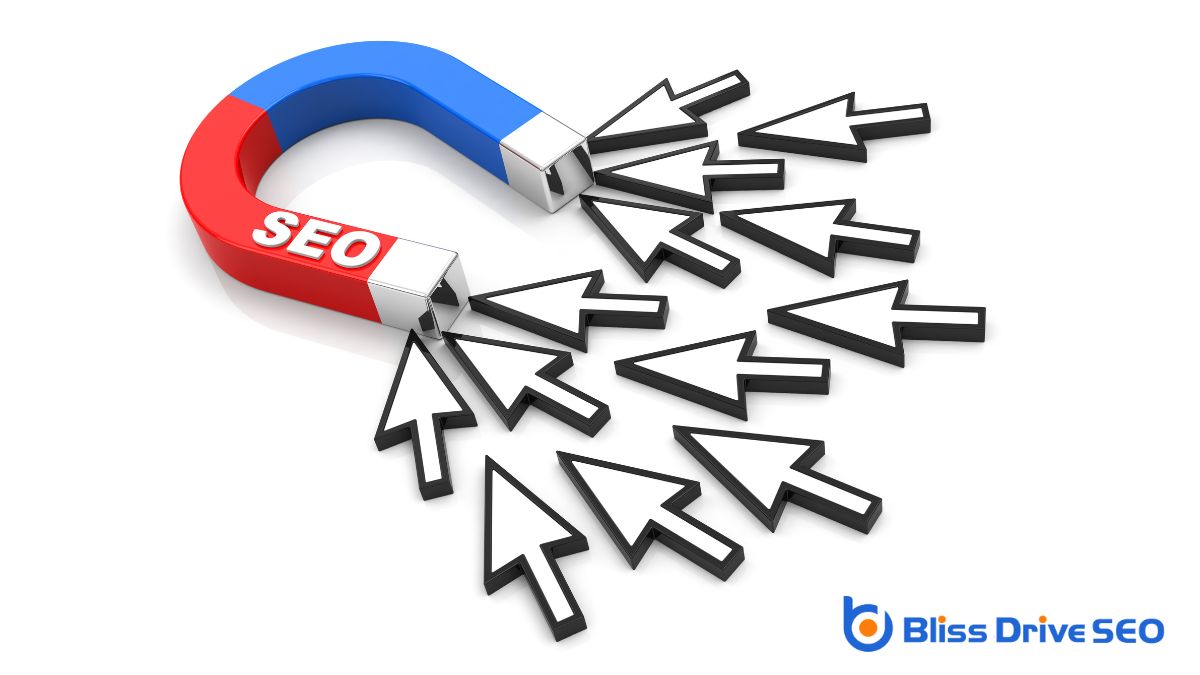Digital Marketing Services
Learn More About Us

To get started with local SEOOptimization strategies aimed at improving a website’s visibility in local search results. on Google, you need to focus on optimizing your Google Business Profile, ensuring it's filled with precise information and high-quality images. It's essential to incorporate local keywordsWords or phrases that users type into search engines to find information. into your website content and meta tagsHTML tags that provide information about a web page to search engines and visitors. to enhance visibility for local searches. But that's just the beginning. Have you ever wondered how customer reviews and local citations play into the bigger picture? Understanding these elements can greatly impact your strategy. Ready to explore how these tactics can elevate your business's local presence and discover more about location-based content creation?
Optimizing your Google Business Profile is crucial for improving your local SEO and attracting more customers. It's a powerful tool that lets you control how your business appears on Google Search and Maps. Start by claiming your business if you haven't already. Go to Google Business Profile Manager, search for your business, and follow the prompts to verify your ownership. Once claimed, make sure all your business details are accurate and complete, including your address, phone number, and business hours.
Add high-quality photos of your business, products, or services. Images make your profile more engaging and help potential customers get a sense of what you offerThe specific product or service being promoted by affiliates.. Regularly update these photos to keep your profile fresh.
Encourage customers to leave reviews and respond to them promptly. Reviews build trust and can greatly influence potential customers' decisions.
Don't forget to include a compelling business description. Clearly describe what you do, and highlight what makes your business unique. Use attributes to specify any special features or services your business offers.

To boost your local SEO on Google, start by identifying relevant local terms that your audience uses. Incorporate these keywords naturally into your content, ensuring you highlight your location to attract nearby customers. By doing so, you'll improve your visibility in local search results and connect more effectively with your community.
Harnessing the power of local keywords is essential for boosting your local SEO efforts. To identify relevant local terms, start by thinking like your customers. What words or phrases would they use when searching for a business like yours? Consider specific products, services, and locations.
For example, if you own a bakery in Austin, terms like "Austin bakery," "best cupcakes in Austin," or "gluten-free bread Austin" could be relevant.
Use tools like Google's Keyword Planner or Ubersuggest to discover popular local search terms. These tools can show you how often particular keywords are searched and suggest related terms you mightn't have considered. Pay attention to keywords that have a good balance of search volume and competition.
Don't forget to check out your competition. Look at their websites and see what keywords they're targeting. This can give you insight into what's working in your area and help you find gaps you can fill.
Once you've compiled a list of potential keywords, prioritize them based on relevance and potential impact. Remember, the goal is to attract local customers who are actively searching for what you offer, so choose terms that truly reflect your business.
Start by integrating these local keywords naturally into your website's content, such as in service descriptions, blog posts, and even image alt texts. Be mindful to maintain readability and not overstuff keywords, as this can negatively impact your site's ranking. Instead, focus on creating informative, engaging content that seamlessly includes these terms.
Also, remember to update your meta titles and descriptions with local keywords. This helps search engines understand where you are and what you do, increasing your chances of appearing in local search results.
Additionally, consider creating location-specific landing pages if you serve multiple areas. They can provide detailed information tailored to each location, boosting your visibility in those regions. By doing this, you'll enhance your local SEO and attract more customers from your area.
Customer reviews are a treasure trove of insights and trust-building tools for any local business. They not only help you understand what you're doing right but also highlight areas needing improvement. Potential customers often look at reviews to gauge your reputation and reliability before making a decision. To enhance your local SEO, actively encourage satisfied clients to leave positive feedback on your Google Business Profile.
Start by asking for reviews after a successful service or purchase. You can do this in person, via email, or through social media. Make it easy for customers by providing direct links to your review page. When customers see that you value their opinions, they feel more connected to your business.
Responding to reviews, whether positive or negative, is essential. It shows you care about your customers' experiences and are willing to address any concerns. This interaction boosts your credibility and can improve your search rankings.
How can local citations help your business thrive?
Local citations are online mentions of your business's name, address, and phone number (NAP). They play a pivotal role in boosting your local search engine rankings. When search engines notice consistent and accurate citations across various platforms, they view your business as credible and trustworthy. This can leadA potential customer referred by an affiliate who has shown interest in the product or service but h... to higher visibility in local search results, making it easier for potential customers to find you.
Building local citations starts with ensuring your NAP information is consistent across all listings. Even small discrepancies can confuse search engines and harm your rankings. Begin by listing your business on major directories like Google My Business, Yelp, and Bing Places. Don't overlook niche directories specific to your industry; they can be just as valuable.
Monitor and update your citations regularly. If your business moves or changes its phone number, update all listings promptly. Use tools like Moz Local or BrightLocal to simplify this process, helping you track and manage your citations efficiently.
Local citations lay a strong foundation for your business's online presence, but to truly connect with your audience, it's important to create location-based content. When you tailor content to your specific area, you engage local customers and improve your visibility in local search results.
Start by incorporating local landmarks, events, and culture into your website and blog posts. This not only makes your content relatable but also helps you stand out from generic competitors.
Think about the questions locals might've and answer them directly. If you're a restaurant owner, discuss local ingredients or collaborate with nearby farms. By doing so, you provide value and demonstrate your community involvement, fostering trust with potential customers.
Additionally, consider creating guides for your area. Whether it's "Top 5 Attractions in [Your City]" or "Best Hiking Trails Near [Your Location]," these guides position you as an authority in your niche and area. Use relevant keywords naturally so search engines can easily index and rank your content.
Don't forget to engage with local influencersIndividuals with the power to affect the purchasing decisions of others due to their authority, know... or partner with local businesses for content collaborations. This strategy expands your reach and taps into their audience, boosting your local SEO efforts effectively.

To effectively monitor your local SEO performance, start by tracking keyword rankings to see how well your business appears in search results.
Analyze traffic sources to understand where your visitors are coming from and which channels are driving the most traffic.
Although optimizing your local SEO strategy is crucial, it's just as essential to track keyword rankings to monitor their performance effectively. Keeping an eye on where your business appears in search results tells you which keywords are working and which ones need tweaking. By tracking these rankings, you can identify trends over time, understand what's boosting your visibility, and make informed decisions to improve your strategy.
Start by selecting the right tools to track your keyword rankings. There are numerous SEO toolsSoftware and online tools used for various aspects of SEO, such as keyword research and link buildin... available, such as Google Search ConsoleA tool by Google that helps monitor and maintain your site's presence in search results., Moz, and SEMrush, which provide insights into how your keywords are performing. These tools help you see how your website ranks for specific local keywords and phrases, offering valuable data to adjust your SEO tactics.
Regularly checking your keyword rankings allows you to spot any significant changes that might indicate issues or opportunities. If you notice a drop in rankings, it might be time to revisit your content, update your website, or analyze your competitors.
On the other hand, a rise in rankings shows that your efforts are paying off. Stay proactive, and make adjustments as needed to maintain and improve your local search presence.
Understanding where your website traffic originates from is essential for monitoring your local SEO performance. When you know which sources drive visitors to your site, you can make informed decisions to optimize your strategy. Start by using tools like Google AnalyticsA web analytics service offered by Google that tracks and reports website traffic. to identify the main origins of your traffic.
Look at direct visits, organic searches, referrals, and social media channels. Each source provides insights into how effectively you're reaching your local audience.
Direct traffic could indicate strong brand recognitionThe ability of consumers to identify a brand by its attributes, such as logo, color, or packaging., while organic search reveals your visibility in search engine results. Referrals show partnerships or backlinksLinks from other websites pointing to your website, crucial for SEO. contributing to your traffic, and social media numbers highlight how engaging your content is on various platforms.
By analyzing these sources, you can determine which areas need improvement and which strategies are working.
You should focus on increasing your organic search traffic since it reflects your SEO efforts. Consider optimizing your Google My Business profile, local keywords, and online reviews to enhance visibility. Additionally, maintain a balanced approach by nurturing other channels like social media and referrals.
Plunge into evaluating engagement metricsMetrics that measure user interaction with a website, such as time on site and pages per session. to truly understand how your local SEO efforts are resonating with your audience. Start by looking at key indicators like bounce rateThe percentage of visitors who leave a website after viewing only one page., pages per session, and average session duration. These metrics can highlight whether your content is engaging users effectively or if there's room for improvement.
A low bounce rate might suggest that visitors find your content relevant, while a high one could indicate a mismatch between what users expect and what they find.
Next, pay attention to click-through rates (CTR) for your local listings. A high CTR means your listings are appealing and your meta descriptions and titles are compelling. This is essential for drawing in potential customers. If you notice a low CTR, consider refining your titles and descriptions to better align with user intent.
Don't forget to monitor conversionThe completion of a desired action by a referred user, such as making a purchase or filling out a fo... rates from local search traffic. This metric reveals how many site visitors are taking desired actions, like filling out a contact form or making a purchase. High conversion rates often mean your site meets user needs effectively. By regularly evaluating these engagementThe interactions that users have with a brand’s content on social media. metrics, you can refine your strategies, ensuring they're always aligned with local user expectations and behaviors.
To effectively boost your local SEO on Google, make sure you've optimized your Google Business Profile with accurate details and eye-catching images. Don't forget to incorporate local keywords into your content and meta tags. Encourage customers to leave reviews and build citations on major directories. Craft location-based content that resonates with your audience. Keep a close eye on your traffic sources, engagement, and keyword rankings to refine your strategy over time. These steps will enhance your local online presence.
